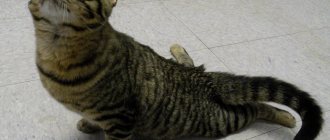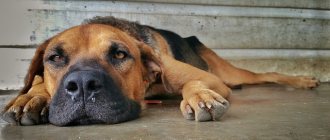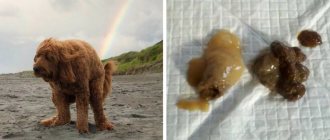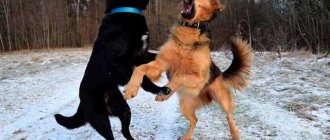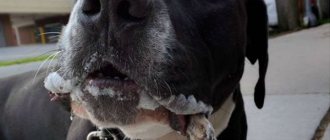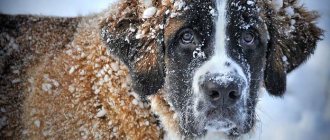If a dog rubs its butt on the floor, then most likely it is bothered by itching or aching pain. Of course, it is not very pleasant to watch an animal wipe the remains of feces on clean carpets. However, it is worth scolding your pet for such behavior. You need to contact a veterinarian and find out why the dog rides on its butt, because in rare cases, the cause of this behavior may be the development of cancer. There is no need to worry in advance; in most cases, funny behavior only indicates the animal’s desire for cleanliness. Some clean dogs prefer to clean the anal area not with the tongue, but by wiping the butt on the floor.
Parasites
Regular deworming does not provide a 100% guarantee of the absence of parasites in the animal’s body. Tapeworms, roundworms, and helminths actively multiply in feces and can provoke quite intense itching in the anal area. If a dog rides on its butt, it only means that the animal is trying to scratch a hard-to-reach area.
To independently make a preliminary diagnosis, the owner must carefully examine the stool for white larvae and threads. If the initial diagnosis confirms helminthic infestation, then it is necessary to carry out deworming with the help of veterinary agents. You should not experiment and feed your pet garlic and pumpkin seeds. A veterinarian or professional pharmacist will select safe but effective medications.
Sometimes the cause of itching in the anal area can be a flea infestation. The most intense symptom may appear immediately after bathing the animal (parasites try to find dry places and accumulate on the face and genitals). You just need to wash the dog using a special shampoo.
Anal gland problems
If the dog rides on its butt, but there are no worms, then it is likely that the anal glands are clogged or inflamed. Small breeds especially often suffer from this problem. The anal glands are located on either side of the animal's anus and look like small sacs.
A special secretion is collected in the skin sacs, which is used to mark the territory and attract females. In a healthy animal, fluid accumulated in the glands is released during bowel movements. But sometimes the secretion accumulates inside the pouches for quite a long time and begins to put pressure on the surrounding tissues, which leads to some discomfort. As a result, the dog tries to clear the glands by pressing them against a hard surface (particularly the floor). But sometimes the animal can rub its butt against corners and walls.
The true causes of gland blockage are not known for certain. But most often the problem occurs after prolonged diarrhea. Additionally, the animal may begin to lick the area under the tail and whine during defecation. If the owner notices small symmetrical swellings near the anus, then the first thing to do is to gently press on them. You can also wash your pet with warm soapy water. If the swelling does not subside after a few hours, you should contact your veterinarian. After all, ignoring the deviation will lead to infection of the fluid in the glands. Ultimately, the surgeon will have to remove them completely.
How to maintain dog hygiene
Maintaining hygiene and timely implementation of certain actions will help to avoid a situation where the pet will crawl its butt on the carpet. Without the help of the owner, it is difficult for dogs to maintain normal coat condition. Therefore, it is necessary to bathe pets, comb and cut them on a regular basis, and not only in case of emergency.
It is worth walking your pet regularly and for a long time. Dogs need to move more, play, explore new territory so that they don’t start to get bored. As a preventative measure, it is necessary to balance the pet’s diet and exclude harmful foods from it.
Additional Information. It is required to comply with the timing of vaccination and treatment against helminths. It is worth frequently examining the animal’s anus for inflammation and other symptoms of disease. Every 6 months it is necessary to clean the paraanal glands. If blockages occur more often, then it is worth taking the animal for surgery to remove them or shorten the interval.
Cleaning the anal glands
The procedure is quite unpleasant not only at first glance. This is actually quite a dirty job, since the special secret may not only contain the furniture in the room, but also the person doing the cleaning. To make the process safe for the animal, it is recommended to conduct the event in the bathroom. First you need to put on old clothes and protective gloves.
The dog will not sit quietly and wait for the cleaning to finish. For him, the event will be uncomfortable, so it is better to call an assistant who will help restrain the animal. To organize the process, it is first recommended to equip the room with napkins, a basin and Vaseline. Step-by-step procedure:
- Place the dog in the bath, lifting his tail and placing a basin under him. If your pet is a small breed, you can place it itself in the container.
- By palpating the anus, find seals on both sides.
- Lubricate the anus with Vaseline and lightly press on the seals, placing a napkin under them.
- When all the secretion has been extracted, you need to wash the animal and lubricate its anus with Vaseline again.
Note! It is worth contacting a veterinarian if the secretion does not come out of the paraanal glands. If there are wounds and abrasions, they must be treated with an antiseptic to prevent the development of an infectious disease.
Cleaning the dog's anal glands
Four-legged friends cannot directly say what is bothering them, so the owner must independently guess about their well-being. Any changes in behavior should be a clear signal to the pet owner that it is worth examining the animal. There are few causes that cause itching and burning of the anus, but a qualified person should take the history, make a diagnosis and prescribe therapy.
Rectal prolapse
Rectal prolapse is diagnosed when the outermost part of the colon protrudes from the anus. This disease can develop after a dog has suffered from severe diarrhea or constipation for a long time. The animal will feel constant pressure in the anus, so it will instinctively try to straighten the protruding intestine. But it is impossible to help a pet with such a serious problem on your own. You should definitely contact a veterinarian who:
- will straighten the intestine and suture the sphincter muscles to prevent relapse;
- select a wet diet or medications to soften the stool (this will help reduce tension);
- will perform an operation to excise the lower part of the intestine if a relapse does occur.
If it is clearly visible that a lump has appeared under the dog’s tail or the skin near the anus itself is swollen, the use of any traditional methods of treatment is strictly prohibited. There is a small chance that cancer has developed.
Why you can't ignore the problem
If you do not start solving the problem urgently, various complications may arise. These include:
- Fatal outcome after severe intoxication of the body or in the event of intestinal rupture in an advanced case of helminthic infestation.
- Recurrence of an infectious disease due to anal trauma.
- Blood poisoning in advanced cases with suppuration and fistula formation.
- Paralysis of the hind legs, peritonitis, if the pet had an inflammatory process in the paraanal glands.
- Tissue death, damage to the intestinal mucosa due to diseases of the gastrointestinal tract, constipation.
To avoid complications, you need to consult a veterinarian for help, rather than treating your dog at home. You can also avoid troubles if you follow proper hygiene procedures.
Note! Maintaining hygiene in long-haired dogs is also important, since feces that stick to the hairs near the anus can cause constipation.
Paralysis of the dog's hind legs
How to independently identify the cause of deviation
You should not make an appointment with the veterinarian immediately after the animal has “ridden” on its butt on the floor once. It is likely that the pet is simply removing feces stuck in the fur. First of all, you need to try to independently identify the reasons why the dog rides on its butt.
It is necessary to wear clean rubber gloves and carefully examine the rectal area of the pet. The anus and the fur around it should be clean, without matted areas. Sometimes a dog scratches its butt only because the feces have tightly matted the fur, which is why a nagging pain is constantly felt. You also need to carefully examine and palpate the paraanal glands. Any neoplasms or subcutaneous tumors should alert you. You also need to pay attention to whether there is an unpleasant odor coming from under the tail. A persistent putrid odor that persists even after washing the dog indicates that an infection has entered the secretory fluid.
If a small appendage protrudes from the anus itself, this indicates rectal prolapse. If possible, you need to examine the animal's feces to exclude or confirm the presence of helminthic infestation. The type of parasites can only be determined by a veterinarian through analysis. However, the presence of tiny, white worms in the stool will help rule out other causes of itching.
Reasons for riding on your butt
There are several serious diseases that in dogs are accompanied by severe itching and pain in the anal area; usually the diseases are accompanied by other unpleasant symptoms. Therefore, if your pet often or constantly rides on its butt on the floor, you should visit a veterinarian to determine the exact cause of the discomfort.
The main pathologies in which a dog rolls on its butt on the carpet, floor, or grass are infection with worms, inflammation or blockage of the paraanal glands, and rectal prolapse.
Pathological processes in the paraanal glands
The anal glands are a paired organ, located symmetrically on both sides of the anus, and synthesize a special secretion that is pale brown in color with a characteristic odor. These secretions help dogs get to know each other, leave marks on their territory, and scare away unfriendly individuals.
In domestic dogs, the functions of the anal glands atrophy, they are cleansed during defecation, but often for various reasons, stagnation of the secretion occurs, it becomes thick, and the ducts become clogged. At the same time, new portions of a specific fluid continue to be released, putting pressure on the walls of the organ, itching and pain occur, in order to relieve the discomfort, the pet sits on its butt and rides.
The disease often develops due to improper feeding, a sedentary lifestyle of the pet, hypothermia, weakened immunity, long-term problems with stool; in puppies, the pathology occurs when the muscle tone of the sphincter in the anus decreases.
If a dog constantly crawls with its butt on a dirty surface, pathogenic bacteria will penetrate into microcracks and a strong inflammatory process will begin, which will lead to the development of a hidden abscess, peritonitis, and the formation of fistulas.
Worm infestations
If a dog has diarrhea, it often rides on its butt, most likely the discomfort is caused by parasites - when there is a large accumulation of worms in the body, they begin to move from the upper intestines to the lower part of the rectum.
When infected with worms, the pet quickly loses weight, there are frequent bouts of vomiting, abnormal bowel movements, the coat becomes dull, the animal quickly gets tired, sometimes parasites can be seen in the feces and vomit, and puppies have a very bloated stomach.
Dogs become infected with round and flat worms and flukes.
Rectal prolapse
The pet whines, rides on its butt, although it has been wormed, the owner needs to carefully examine the animal’s anus; dogs often have prolapsed rectum. The disease develops with frequent or prolonged diarrhea, constipation, against the background of helminthiases, and with problems with the organs of the urinary system.
Other reasons
If there are no worms, no pathology of the anus is detected, and the puppy or adult dog rides on its butt, bites its tail, and the animal’s health and behavior are normal, this can be a kind of hygienic ritual.
After toileting, feces often get stuck in thick fur, the hairs stick together, which causes severe discomfort; similar problems occur in females during estrus. In pets with long hair, tangles may form near the anus, the skin becomes tight, and itching occurs.
Sharp bones, hard feces, or a foreign object can injure the walls of the rectum, which causes pain during bowel movements.
Dogs are clean animals, but they do not always want to lick the anal area after going to the toilet; cleansing is done by rolling on their butts. The owner needs to stop such liberties, wash the pet after going outside, and trim the fur around the anus.
Research in the clinic
Only a veterinarian can determine the exact reason why a dog rides on its butt and prescribe treatment. At the first appointment, the specialist will assess the general condition of the animal and conduct a thorough rectal examination. Sometimes palpation alone will be enough, but in advanced cases a specialist can perform a colonoscopy. If it is clearly visible that the paraanal glands are swollen, the specialist will take a small amount of fluid for cytological examination. If subcutaneous neoplasms of an unspecified nature are identified under the tail, then a biopsy, ultrasound and computed tomography are performed. A full range of studies will confirm or exclude cancer at a very early stage.
When should you take your animal to the doctor?
You should immediately contact a veterinary clinic if your pet develops bleeding or nodules. However, even in their absence, it is recommended not to delay visiting a doctor, since only a veterinary clinic can find out what pathologies the animal has and also prescribe the required treatment.
Palpation of the dog's abdomen
It is not recommended to give your pet anti-worm medications on your own, since along with the death of the parasites, intoxication of the animal’s body can occur. Suppuration can only be removed through surgery. During the operation, it is opened, cleared of pus and treated with saline solution.
If the procedure was caused by an inflammatory process of the paraanal glands, then they are also excised during the operation, and subsequent treatment includes the use of antibiotics. Intestinal diseases can be treated with diets and medications prescribed by a doctor. Surgery is only necessary in severe cases.
Is it possible to prevent itching in the anal area?
Although discomfort under the tail is not always a sign of any serious illness in your pet, it is necessary to pay enough attention to preventative procedures. Firstly, owners of long-haired dog breeds need to regularly ensure that feces do not get tangled in the animal's fur. You can contact a groomer to trim off the excess. It is also necessary to regularly deworm and wash the anal glands, especially for those dogs that have previously suffered from inflammation. Simple hygiene procedures will prevent many unpleasant diseases and complications.
You can also contact our site's staff veterinarian, who will respond to them as soon as possible in the comment box below.



